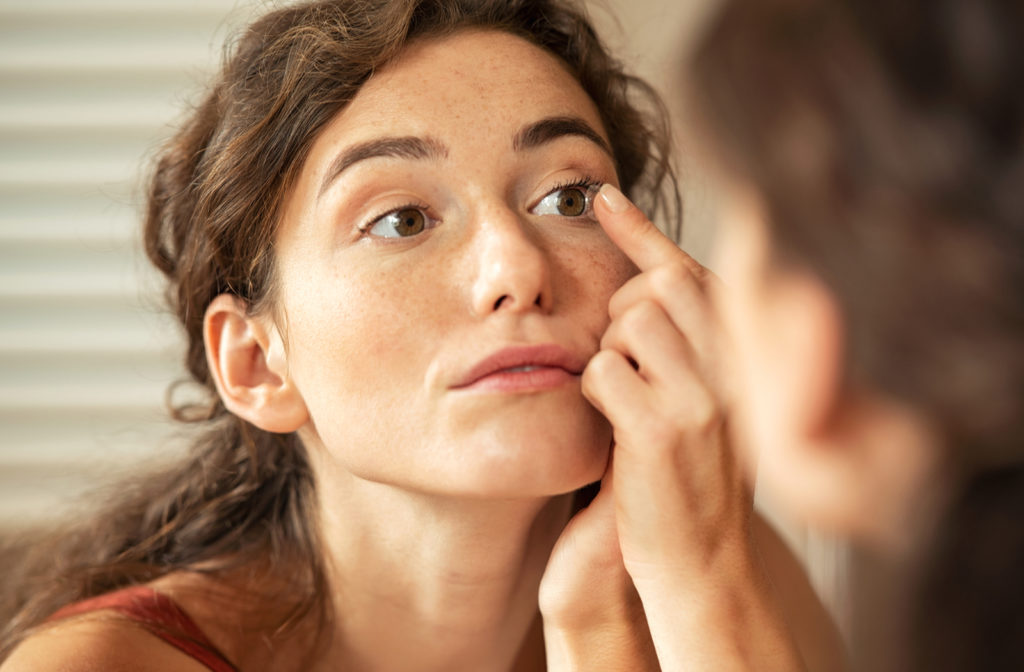If you are experiencing refractive errors like astigmatism, farsightedness, or nearsightedness, you may want to consider Orthokeratology (Ortho K). Compared to methods like refractive surgery, Ortho K is an unobtrusive way to correct refractive errors. Ortho K does so through the use of special contact lenses.
If you are curious about what treatment options are available to correct a potential refractive issue with your eyes, book an appointment with one of our optometrists to receive a diagnosis and explore your options for corrective measures.
What is Ortho K (Corneal Reshaping)?
Ortho K is a non-surgical way to correct refractive errors by temporarily changing the shape of your lens and cornea through the use of corneal reshaping contact lenses. The contact lenses used in Ortho K are hard and gas permeable, which means they will retain their shape at all times. Typically, during Ortho K treatment, these contact lenses will be worn while you sleep, gently reshaping the surface of your eye.
Most often, Ortho K is used to treat myopia (nearsightedness), but can also help correct other refractive errors. The effects of Ortho K treatments are reversible, but can be maintained if the treatment is continuously followed.
How Does Ortho K Work?
Ortho K deals with the process of reshaping your cornea and lens. The cornea is a clear, dome-shaped window in the front of your eye that focuses light onto the retina and is responsible for most of the eye’s ability to focus.
First, an optometrist will map and measure the surface of your cornea using an instrument called a corneal topographer and then design a lens specially for your eye. This map is created by reflecting light off the surface of the eye. The corneal topography map is used to show the shape and curves of your cornea.
The corneal reshaping lenses work by flattening the center of the cornea, which changes how light is bent as it enters the eye. Most corneal reshaping lenses are worn overnight to flatten the cornea, then removed during the day. Corneal reshaping lenses are rigid, gas-permeable lenses that are sturdy enough to reshape the cornea, but also allow oxygen through so your eye stays healthy.
During the day when you are not wearing corneal reshaping lenses, the cornea stays flattened for a while, and vision is corrected without the need for glasses. If you are not following your treatment plan and stop wearing the lenses at night, your eyes will eventually go back to their original shape and the refractive error will return.

How Long Does Ortho K Take to Work?
The effects of Ortho K can vary based on the severity of your refractive error. Some people experience improved vision after a day or two of overnight Ortho K, but people with more severe refractive issues can take two or more weeks for maximum correction.
During the Ortho K treatment process, you might notice blurred vision, glare, and halos around lights. Also, in some cases, you may need to wear glasses during the Ortho K process, but the prescription you will need is going to be much lower than your prescription without Ortho K treatment.
Refractive Errors
Myopia (Nearsightedness)
Myopia is a common vision problem that allows you to see things close to you clearly, but objects far away will be blurry. Myopia occurs due to the shape of your eye incorrectly refracting light so it focuses before it reaches your retina instead of focusing at the point light reaches your retina.
Myopia can develop rapidly or quite slowly, and it is often transferred through genetics. The best way to confirm if you are experiencing myopia is to receive a comprehensive eye examination.
Many children can develop myopia early on in life, severely affecting their quality of life and ability to learn. Myopia can put your child at risk of developing eye diseases like retinal detachment, glaucoma, cataracts, and macular degeneration, so it is important to consider getting your child examined for refractive errors.
Hyperopia (Farsightedness)
Hyperopia is another common vision condition in which you can see distant things clearly, but objects nearby are blurry. The degree of your farsightedness influences your ability to focus. People with severe farsightedness may be able to only see objects clearly at a great distance away, while those with mild farsightedness may be able to clearly see objects that are closer.
Astigmatism
Astigmatism is a generally treatable imperfection in the curvature of your eye that causes blurred distance and near vision. Astigmatism occurs when either your cornea or the lens of your eye has mismatched curves; Instead of having a spherical shape, the surface of your eye is ovular or cylindrical. This causes blurred vision at all distances, not just near or far.
Astigmatism is often present at birth and may occur in combination with nearsightedness or farsightedness. In cases where it is not pronounced enough, astigmatism does not require corrective action. When it is, your treatment options are corrective lenses or surgery.
See Your Optometrist
Contact your optometrist today to learn more about Ortho K and how corneal reshaping can help prevent future refractive eye errors.


